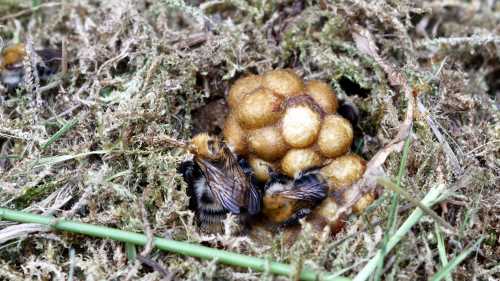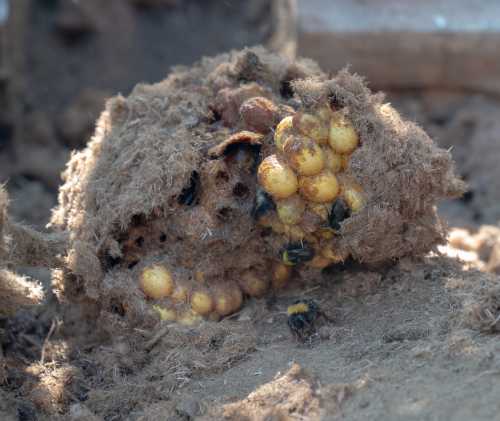How Many Bumble Bees In A Colony?
Question:
How many bumble bees are there in a colony and where do bumble bees raise their colonies?
The short answer is:
Depending on species, most colonies range from small (20 - 100 workers), to large (up to 400 workers). However, in some countries, there are bumble bee species that can raise a colony with over 1000 workers.
Some bumble bee species raise their colonies underground. Several species prefer to nest on patches of moss or tussocks of grass, whilst others prefer to nest above ground.
How Many Bumble Bees In A Colony?
 A Bombus pascuorum colony nest on a grassy, mossy surface
A Bombus pascuorum colony nest on a grassy, mossy surface
In his book, Bumblebees Behaviour And Ecology, Professor Dave Goulson comments that in Britain, a large colony size of 100 - 400 workers might be reared by Bombus terrestris (Buff-tailed bumble bee) and Bombus Lapidarius (Red-tailed bumble bee).
In contrast, he notes that small colonies with 20 - 100 workers are likely for Bombus pascuorum(Common carder), Bombus sylvarum (Shrill Carder bee), Bombus ruderarius (Red-shanked Carder bee), and Bombus muscorum (Moss Carder bee).
Falk provides the following data for approximate nest sizes of British bumble bee species.
| Species | Common Name | Colony Size |
|---|---|---|
| Bombus lucorum | White-tailed bumble bee | Over 200 workers |
| Bombus terrestris | Buff-tailed bumble bee | 500 or more individuals |
| Bombus distinguendus | Great Yellow bumble bee | Around 12 workers |
| Bombus hortorum | Garden bumble bee | Fewer than 100 workers |
| Bombus humilis | Brown-banded Carder bee | 40 - 50 workers |
| Bombus hypnorum | Tree bumble bee | 150 or more workers |
| Bombus jonellus | Heath bumble bee | About 50 workers |
| Bombus lapidarius | Red-tailed bumble bee | Upto 300 workers |
| Bombus monticola | Bilberry bumble bee | Fewer than 50 workers |
| Bombus muscorum | Moss Carder bee | 40 - 120 workers |
| Bombus pascuorum | Common Carder bee | 60 - 150 workers |
| Bombus pratorum | Early bumble bee | Upto 100 workers |
| Bombus ruderarius | Red-shanked Carder bee | Upto 100 workers, often significantly fewer |
| Bombus ruderatus | Ruderal bumble bee | Upto 150 workers |
| Bombus soreensis | Broken-belted bumble bee | 80 - 150 workers |
| Bombus subterraneus | Short-haired bumble bee | 75 - 100 workers |
| Bombus sylvarum | Shrill Carder bee | Fewer than 50 workers |
Above data compiled from Field Guide to Bees Of Great Britain And Ireland - by Steven Falk.
However, a 2015 study providing data from other regions of the world, including USA and Japan, indicated significant differences in bumble bee colony size. For example, the colony of Bombus vosnesenskii found in California contained 1848 workers1.
| Species | Colony Size (Number Of Workers) | Location of Colonies (Number In Brackets Indicates Number Of Colonies In Study Sample) | Collecting Month |
|---|---|---|---|
| Bombus ardens | 43 | Honshu Island, Japan (5) | May, June |
| Bombus atratus | 54.3 | Facatativa, Colombia (5); Loja, Ecuador (2) | February, April, July |
| Bombus brasilensis | 42 | Antonina, Parana, Brazil (1) | February |
| Bombus diversus | 271.5 | Honshu Island, Japan (8) | June, July, August, September |
| Bombus ephippiatus | 465 | Monteverde and Volcan Irazu, Costa Rica (2) | February, July |
| Bombus honshuensis | 40 | Honshu Island, Japan (6) | July, August, October |
| Bombus huntii | 515 | Ruidoso New Mexico, USA (1) | August |
| Bombus hypocrita | 38 | Honshu Island, Japan (5) | July, August |
| Bombus ignitus | 62.5 | Honshu Island, Japan (8) | June, July, August, September |
| Bombus impatiens | 465 | Michigan, USA (1) | August |
| Bombus lucorum | 121.2 | Basel, Switzerland (5) | April |
| Bombus medius | 800 | San Luis Potosi, Mexico (1) | June |
| Bombus melaleucus | 43 | El Porvenir; Colombia (1) | Unreported |
| Bombus morio | 67.5 | Alexandra, Parana, Brazil (2) | February |
| Bombus pennsylvanicus | 150 | Willcox, Arizona, USA (1) | August, September |
| Bombus pseudobaicalensis | 20 | Hokkaido Island, Japan (1) | August |
| Bombus pullatus | 336.5 | San Vito de Java, Costa Rica (2) | June, July |
| Bombus schrencki | 25.5 | Hokkaido Island, Japan (2) | August, September |
| Bombus terrestris | 150 | Hobart, New Zealand (2) | February, October |
| Bombus transversalis | 118.6 | Napo River, Ecuador (1); Tambopata River, Peru (2) | April, October |
| Bombus vosnesenskii | 1848 | Tilden Park, California, USA (1) | June |
(Table data adapted from Cueva Del Castillo et al, 20151).
What factors affect the size of a bumble bee colony?
Goulson2 found that in general, colony size correlates positively with bumble bees' foraging range, with bee colonies foraging over larger distances generally having bigger colonies.
Also, a large food supply means a larger workforce that will provide more help, including food provisioning, brood care, and defense of the colony, as well as a subsequent increased production of queens (Owen et al. 19803).
Of course, colony size may be impacted by threats to bumble bee nests.
For example, a 2015 study showed that bumble bee colony size was negatively affected by the use of fungicides, resulting in colonies of Bombus impatiens having fewer workers5.
A study of 908 bumble bee nests in Britain between 2008 and 20134, found that colony survival, (measured by success in producing new queens) ranged from as little as 41% for the native Bombus hortorum, to 96% for the recent newcomer, the tree bumble bee, Bombus hypnorum.
The top 4 reasons for colony failure in order of most commonly occurring, were:
1. excavation of the burrow,
2. human disturbance of the nest,
3. flooding and
4. wax moth.

Do all bumble bees live in colonies?
Yes, although it must be pointed out that cuckoo species do not establish their own, rather they take over colonies established by host queens, often dominating her workers and any food provisions in the nest.
Where do bumble bees raise their colonies?
 Location of a Bombus hypnorum - in a bird nest box.
Location of a Bombus hypnorum - in a bird nest box.Some bumble bee species prefer to make use of burrows underground, such as abandoned mouse holes, but also other crevices may suffice. Other species, notably the carders, nest on the surface of the ground, typically on tufts of grass and mossy banks.
Other species nest in tree crevices or even abandoned bird boxes.
Read more about bumble bee nests.
References
1. Cueva Del Castillo R, Sanabria-Urbán S, Serrano-Meneses MA. Trade-offs in the evolution of bumblebee colony and body size: a comparative analysis. Ecol Evol. 2015;5(18):3914-3926. Published 2015 Aug 25. doi:10.1002/ece3.1659.
2. Goulson, D. 2010. Bumblebees, behavior and ecology. Oxford Univ. Press, Oxford, U.K, Pp. 81.
3. Owen, R. E. , Rodd F. H., and Plowright R. C.. 1980. Sex ratio in bumblebee colonies‐complications due to orphaning. Behav. Ecol. Sociobiol. 7:287–291.
4. Goulson, D., O'Connor, S. and Park, K.J. (2018), Causes of colony mortality in bumblebees. Anim Conserv, 21: 45-53. https://doi.org/10.1111/acv.12363.
5. Bernauer OM, Gaines-Day HR, Steffan SA. Colonies of Bumble Bees (Bombus impatiens) Produce Fewer Workers, Less Bee Biomass, and Have Smaller Mother Queens Following Fungicide Exposure. Insects. 2015;6(2):478-488. Published 2015 Jun 1. doi:10.3390/insects6020478.



